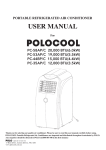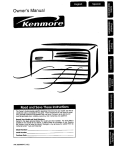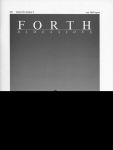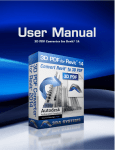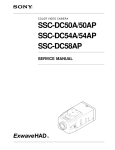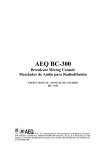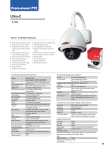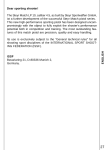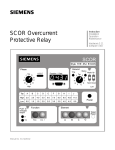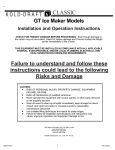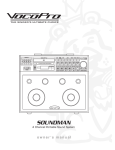Download POLOCOOL POLOCOOL - ProductReview.com.au
Transcript
PORTABLE TYPE AIR CONDITIONER PORTABLE REFRIGERATED AIR CONDITIONER USER MANUAL USER MANUAL POLOCOOL For POLOCOOLNC 34/BP For PC-58AP/C 20,000 BTU(6.0kW) NC PC-44BP/C 15,000 BTU(4.4kW) PC-35AP/C 12,000 BTU(3.5kW) 39/BP Thank you for selecting our quality air conditioner. Please be sure to read this user manual carefully before using. POLOCOOL Portable Refrigerated Air Conditioners are imported and distributed throughout Australiasia by NOBO. Any enquiries should be for directed to NOBO on 1800air myconditioner. nobo or 1800 69 6626 theto first instance. Thank you selecting our quality please be in sure read this user manual Australia 80 749using. 103 558 Any question, please contact the professional service for help. carefullyABN before 17 Brett Drive, Carrum Downs, VIC 3201 www.nobo.com.au Important Issues Regarding the Proper Use of this Air Conditioner Please contact NOBO on 1800 my nobo or 1800 69 6626 for advice before returning unit to the place of purchase. Use this air conditioner only as described in this instruction manual. • T his appliance is fitted with a special safety device. When the compressor switches off or when the appliance is first turned on, this device prevents the compressor from switching on again for at least three minutes. • This air conditioner has been designed and manufactured to operate in a domestic situation only and should not be used for other purposes. • The appliance is not intended for use by young children or infirm persons. • Never use the air conditioner in damp rooms (eg bathrooms and laundries) • If the power cord is damaged, it must be replaced with a new cord installed by a suitably qualified person or POLO / NOBO serviceman. • This air conditioner is designed to be connected to a standard 10 amp power supply outlet. • Do not pull on or place strain on the power cord when using the appliance. • Do not operate or stop the appliance by inserting or pulling out the power plug. Use the on/off switch on the air conditioner control panel or the remote control. • Due to potential safety hazards, do not use an extension cord or share the power supply outlet with other appliances. Do not connect to multiple power outlets on extension leads. • Do not rest hot or heavy objects on the appliance. • Always unplug the unit from the power outlet before cleaning or maintenance operations, for example filter cleaning. • Do not place the air conditioner or plastic window slider in direct sunlight. • For maximum cooling efficiency keep the exhaust hose as short and as free of bends as possible. • Clean the filters at least once every two weeks. • Do not splash the unit with water. • Do not move the unit by pulling the exhaust hose attached to the back of the unit. • Do not move air conditioner when it is operating. • Do not use the unit with the air intake and outlet grills closed, covered or obstructed. • Before transporting the air conditioner, drain the water pan in accordance with the instructions on page 14. After transportation, wait at least one hour before switching the unit on. • The unit should be transported in a vertical position. If this is not possible, secure the unit at an angle, do not lay it horizontally. • Do not operate the air conditioner outdoors or in areas open to the outdoors. • If the air conditioner is only being used as a spot cooler (simply to put cool air directly on a person or thing), do not connect the rear exhaust outlet. • If the compressor runs without cool air coming out of the top air outlet after 10 minutes of correct operation, switch off the unit and contact NOBO immediately. • When the compressor is running, hot air should always be expelled from the bottom rear outlet. If it is not, switch off and contact NOBO immediately. • At high temperatures to protect the unit from overheating the compressor may stop. Air will flow out of the front air outlet but it will not be cooled. In this event, switch off the appliance for approximately one hour to enable the thermal cut out to self reset. The unit may then be operated in the normal manner. THIS PRODUCT IS FOR HOUSEHOLD USE ONLY RETAIN THIS MANUAL FOR FUTURE REFERENCE 1 CONTENTS Introduction......................................................................................... 3 Installation........................................................................................... 6 Control panel....................................................................................... 10 Operation of control panel.................................................................. 10 Operation of remote control................................................................ 12 Water drainage methods...................................................................... 14 Maintenance and service..................................................................... 15 Trouble shooting................................................................................. 17 2 INTRODUCTION This portable air conditioner can alter the room temperature and humidity. It has multiple functions of cooling dehumidifying (drying) and fan ventilation, and can be moved from room to room and transported from building to building easily. The air conditioner can maintain set room indoor air temperatures between 18°C and 32°C. The set room temperature is displayed on the remote control and in the control panel on the unit. This does not mean that the air conditioner will necessarily reduce the actual room temperature to the set room temperature. 1 HOW YOUR POLOCOOL PORTABLE REFRIGERATED AIR CONDITIONER WORKS Air from the room is drawn into the air conditioner, cooled by refrigeration, and blown into the room through the front grill. hot air (outside) cool air Hot air is blown outside through the exhaust hose, using the window kit supplied with the air conditioner. Hot air must be exhausted outside the room being cooled, or you will not cool the room. room air 2 VARIABLES INFLUENCING THE COOLING EFFECTIVENESS OF THIS AIR CONDITIONER N W E S The ability of the air conditioner to cool the air in your room depends on a number of variables. The critical variables are: 1. Orientation of the room to the sun. Rooms facing North and West are exposed to the midday and afternoon sun, and are the hottest in the house. Rooms facing the morning sun (East), and away from the sun (South), are the coolest in the house. morning afternoon 2. Insulation sun sun Insulated roofs and walls reduce the amount of heat entering the room. Windows admit heat into the room. This heat can be reduced if the windows are protected from the direct sun (eg by outside blinds, well lined inside curtains, pergolas, thick foliage etc). 3. Air Draughts Rooms protected from draughts are more easily cooled. Windows and doors must be kept closed. 4. Multi Storey Buildings In multi storey buildings, upper storey rooms are usually hotter and therefore harder to cool than ground floor rooms. 3 SIZING GUIDE In general the higher the cooling capacity (BTU/kW) of an air conditioner, the bigger the room it will cool. (a) The PC-53AP/C – 19,000 explained in box 2, can (a)T he PC-58AP/C 20,000 BTU air conditioner, subject to the variables as explained in point 2, effectively can cool rooms with a floor area of between 20 metres. and 42 square metres. cooleffectively rooms with a floor area of between 18 and 39 square 6.5m 7m Example Example 1: 1: Uninsulated Uninsulated upper upper storey storey room room with with one one West West facing facing external external wall. wall. 4m 4m In In this this example, example, the the air air conditioner conditioner is is suitable suitable for for effectively effectively cooling cooling a a room room of of up up to to 18 20 square square metres. metres. 4.5m 5m Example Exampleof ofmaximum minimum room room size size 2 4m x 4.5m 4m x 5m = = 18m 20m2 Example Example 2: 2: Insulated Insulated ground ground floor floor room room with with external external walls walls facing facing East East 6m 6m and/or and/or South. South. In In this this example, example, the the air air conditioner conditioner is is suitable suitable for for effectively effectively cooling cooling a a room room of of up up to to 39 42 square square metres. metres. Example Example of of maximum maximum room room size size 2 6m x 6.5m 6m x 7m = = 39m 42m2 Continues on the next2, page (b) The PC-44BP/C – 15,000 BTU air conditioner, subject to the variables explained in box can effectively cool rooms with a floor area of between 9 and 30 square metres. 3 Example 1: 3m Example 2: Insulated ground floor 6m 3 SIZING GUIDE In general the higher the cooling capacity (BTU/kW) of an air conditioner, the bigger the room it will cool. (a) The in box 2, can (b) The PC-53AP/C PC-44BP/C –– 19,000 15,000 BTU BTU air air conditioner, conditioner, subject subject to to the the variables variables explained as explained in point 2,effectively cool rooms with a floor area of between 18 and 39 square metres. can effectively cool rooms with a floor area of between 9 and 30 square metres. 6.5m 6m Example 1: 1: Example Uninsulated upper storey storey Uninsulated upper room with with one one West West facing facing room external wall. external wall. 4m 3m In this this example, example, the the air air In conditioner is is suitable suitable for for conditioner effectively cooling a room effectively cooling a room of up up to to 9 18square squaremetres. metres. of 4.5m 3m Example of maximum Example of minimum room size room size 4m x 4.5m = 18m22 3m x 3m = 9m Example 2: 2: Example Insulated ground ground floor floor Insulated room with with external external room walls facing facing East East walls and/or South. and/or South. 6m 5m In this this example, example, the the air air In conditioner is suitable for conditioner is suitable for effectively cooling cooling a a room room effectively of up up to to 30 39 square square metres. metres. of Example of maximum Example of maximum room size room size 6m x 6.5m = 39m22 6m x 5m = 30m (b) The PC-44BP/C – 15,000 BTU air conditioner, subject to the variables explained in box 2, can effectively (c)The PC-35AP/C – 12,000 BTU air conditioner, subject to the variables as explained in point 2, cool rooms with a floor area of between 9 and 30 square metres. can effectively cool rooms with a floor area of between 6 and 20 square metres.6m 5m Example 1: Example 1: Uninsulated upper storey Uninsulated upper room with one Weststorey facing room with one West facing external wall. 3m external wall. In this example, the air 2m In this example, the airfor conditioner is suitable conditioner is suitable for effectively cooling a room effectively coolingmetres. a room of up to 9 square of up to 6 square metres. INTRODUCTION 3m 3m Example of maximum Example of size minimum room room size 3m x 3m = 9m2 3m x 2m = 6m2 Example 2: Example Insulated2:ground floor Insulated floor room withground external room with external walls facing East 5m walls East and/orfacing South. 4m and/or South. In this example, the air In this example, the airfor conditioner is suitable conditioner is suitable for effectively cooling a room effectively a room of up to 30cooling square metres. of up to 20 square metres. Example of maximum Example of maximum room size room size 6m x 5m = 30m2 4m x 5m = 20m2 4 TIPS ON GETTING THE MOST OUT OF YOUR POLOCOOL This portable air conditioner can alter the room temperature and humidity. It has multiple functions of cooling, dehumidifying (drying) and fan ventilation, and can be moved from room to room and transported from building to building easily. PORTABLE AIR CONDITIONER Portable air conditioners conditioners are not18°C designed to cool cool large large open open spaces. spaces. The air conditioner can maintain indoor air temperatures are between and 32°C. to Portable air not designed To the cooling cooling effectiveness effectiveness in in an an enclosed enclosed room: room: To maximise maximise the •Turn the air conditioner on early in the day before the room heats up. It is more the for air the conditioner on early the day the before theatroom heats up. Ittemperature is more • Turn efficient air conditioner toinmaintain room a comfortable efficient the air conditioner to maintain room at a comfortable temperature than it isfor to reduce an already hot room to the a comfortable level. than it is to reduce an already hot room to a comfortable level. GUIDELINES FOR COOLING EFFECTIVENESS •OPTIMISING Close all doors, windows, curtains and external blinds of the room being cooled. • Close all doors, windows, curtains and external blinds of the room being cooled. • Seal or block major draughts. NOBOCOOL portable refrigerated air conditioners have an independently tested cooling capacity of 4200 watts (4.2kW) • Seal or block major draughts. or 15,000 BTU. This is sufficientFOR to coolOPTIMISING rooms up to a maximum of 34 square metres in floor area. GUIDELINES COOLING EFFECTIVENESS POLOCOOL portable refrigerated air conditioners have a cooling capacity of: The maximum effective room size is influenced by several factors including the amount and type of insulation, (1) Model PC-58AP/C – 20,000 BTU or 6.0 kW. This is sufficient to cool rooms with floor areas of between orientation of to 42 thesquare sun, amount of glass areas, type of curtains and ceiling height etc. the room 20 and metres. • • • (2) Modelis PC-44BP/C BTUopen or 4.4kW. This is cool rooms with floor areas of between The air conditioner not designed–to15,000 cool large areas. Close allsufficient doors andtowindows in the room being 9 and 30 square metres. cooled. (3) Model PC-35AP/C – 12,000 BTU or 3.5kW. This is sufficient to cool rooms with floor areas of between 6 and 20 square metres. Do not place the air conditioner in direct sun light. Close all curtains in the room being cooled. • Do not place the air conditioner or plastic window slider in direct sunlight. Close all curtains in the room being cooled. fan and at HIGH. For maximum (COOLING MODE), setMODE), the temperature at 18° C andatthe • F orcooling maximum cooling (COOLING set the temperature 18°C the fanAfter at HIGH. After approximately 3 minutes, thethe compressor will turn onon(indicated control panel) panel) and cooled approximately 3 minutes, compressor will turn (indicatedbybythe thegreen greenLED LEDmarked on marked on the the control • air will come out of the air outlet. Cooled air will only come out of the air outlet when the LED on the control panel is illuminated. control • panel illuminated.MODE the air conditioner will not cool unless the set temperature is below the existing room temperature. InisCOOLING • In COOLING once the existing temperature reaches is thebelow set temperature, the fan continues operating and In COOLING MODE the MODE air conditioner will not coolroom unless the set temperature the existing room temperature. the compressor switches on and off to maintain the set temperature within the room. • ForMODE maximum output keep the exhaust hose as and as straight as possible. In COOLING oncecooling the existing room temperature reaches theshort set temperature, the fan continuesMinimise operating bends which can reduce the maximum cooling capacity of the air conditioner. Elevate the air conditioner if necessary. and the compressor switches on and off to maintain the set temperature within the room. • Make sure the air intake and outlet grills are unobstructed. Keep the• exhaust as short as possible. Cleanhose the filters at and leaststraight once every two weeks. • Make sure the air intake and outlet grills are unobstructed. • Clean the filters at least once every two weeks. and cooled air will come out of the air outlet. Cooled air will only come out of the air outlet when the LED on the • • 4 INTRODUCTION This portable air conditioner is a small size appliance, which can adjust the room temperature and humidity. It has multiple functions of cooling, dehumidifying and fan ventilation, and also a much more compact design comparing with other types air conditioner withAND the same cooling capacity. however, its most remarkable advantage is no professional NAME OFof EACH PART FUNCTION installation and mounting needed, so it could be moved from room to room and transported from building to building easily. Other forms of air conditioning are recommended when the indoor temperature is either below 18°C or above 30°C . NAME OF EACH PART AND FUNCTION FRONT (Fig.1) FRONT (Fig.1) 1 2 3 4 1.1. Control panel Control panel 2.2. Up/down manually adjusted air fins Up/down air swinging fins Airoutlet outlet 3.3. Air Left/Right airair swinging 4.4. Left/Right auto swingingfins fins 5. Caster 5. Rolling castor Cable (power 6.6. Cable (power cordcord and and plug)plug) 6 5 Fig.1 BACK BACK(Fig.2) (Fig.2) 3 1. Hot air outlet grill Lower air inlet 1.2. Hot air outlet grill grill 3. Higher air inlet 2. Low air inlet grill grill Power cordgrill hooks 3.4. High air inlet 5. Water tank / chassis 4. Power cord hooks 6. Water drain mouth 5. Water tank/chassis Plugtank drain outlet 6.7. Water 7. Plug 4 2 1 7 6 3 5 5 Fig.2 INSTALLATION SELECTION OF INSTALLATION LOCATION (Fig.3) Place the portable air conditioner in a flat location where the air inlets and outlets cannot be covered up. Place the unit no less than 50cm away from a wall or other obstacle. ATION LOCATION (Fig.10) ner in a flat location where ed up. Place the unit no less other obstacle. 50cm clearance at back to allow for air outlet hose. 50cm clearance required for air inlet. cm 50 Fig. 16 50cm Fig. 3 (Fig. 17) UNTING METHOD INSTALLATION ACCESSORIES Only 20cm clearance required from this face as it does not contain air inlet or outlet. xhaust hose to the hot air outlet grill at the back of the appliance. arge) to the nearest window. The length of the air exhaust hose is m; use the minimum length when working. p the air exhaust horizontal and not enlarge or connect it to other e malfunction. batteries remote control user manual Fig. 17 6 ASSEMBLY OF EXHAUST HOSE, HOSE INLET, HOSE OUTLET, WINDOW ADAPTOR AND WINDOW SLIDER (Fig.4) • F ully extend each end of the exhaust hose by about 10cm and attach the hose inlet and hose outlet to opposite ends by rotating the inlet/outlet in a counter clockwise direction approximately 3 to 4 turns, making sure that the hose wire is well threaded into the hose inlet and outlet. The hose inlet and outlet cannot be installed unless the hose ends have been fully extended. • Attach the window adaptor to the hose outlet by pressure fit. • C lip the window adaptor into the window slider. Take care to not break the tabs on the window adaptor when disconnecting from the window slider. INSTALLATION SELECTION OF INSTALLATION LOCATION (Fig.10) Place the portable air conditioner in a flat location where the air outlets cannot be covered up. Place the unit no less than 50cm away from a wall or other obstacle. hose outlet hose Fig. 16 hose inlet 50cm cm window adaptor 50 window slider Fig. 4 AIR EXHAUST HOSE MOUNTING METHOD (Fig. 17) ● Fix the square end of the exhaust hose to the hot air outlet grill at the back of the appliance. ● Place the other end (discharge) to the nearest window. The length of the air exhaust hose is 600mm to1500mm; useEXHAUST the minimum length when(Fig.5) working. MOUNTING between OF ASSEMBLED AIR HOSE ● When mounting, try to keep the air exhaust horizontal and not enlarge or connect it to other • Take care not to damageas thethis hose when attaching/detatching at the back discharge caninlet cause malfunction. of the Air Conditioner. • S lide the hose inlet (square end) in the direction indicated by the arrow onto the fixing lugs on hot air outlet grill at the back of the appliance. Install carefully and do not force. • P lace the hose outlet to the nearest window. The length of the air exhaust hose is between 600mm to 1500mm; use the minimum length when working. • W hen mounting, try to keep the air exhaust hose horizontal and do not extend its length by attaching it to another hose as this reduces the cooling efficiency of the appliance. If hose needs to be extended, use as few bends as possible. • Consider elevating the unit in order to keep the hose as straight as possible. Fig. Fig.17 5 7 ATTENTION ATTENTION • • • • • • • • The exhaust hose should be not longer than 1.5metres. The exhaust hose should be not longer than 1.5metres. Never bend the exhaust hose excessively when the appliance is working. Never bend the exhaust hose excessively when the appliance is working. Elevate the unit if possible to keep the exhaust hose straight. Elevate the unit if possible to keep the exhaust hose straight. Always keep the exhaust hose at its shortest length and as straight as possible when the appliance is working. Always keep the exhaust hose at its shortest length and as straight as possible when the appliance is working. This will ensure maximum cooling output. This will ensure maximum cooling output. • Never move the appliance by pulling the air exhaust hose attached to the back of the appliance. • Never move the appliance by pulling the air exhaust hose attached to the back of the appliance. • Do not move the air conditioner when it is operating. • Do not move the air conditioner when it is operating. Correct exhaust hose mounting shown below. If mounting in the wall, the height of the hole should be 17cm~130cm. (Fig. 6) 17cm Fig. 6 If the air exhaust hose needs to be bent, the correct method is shown below. (Fig. 7) Fig. 7 Incorrect or excessive bending of the exhaust hose will cause loss of cooling and possible malfunction. (Fig. 8) Fig. 8 87 NOBOCOOL NC-49DP/C WINDOW SLIDER KIT INSTALLATION (Fig. 9, Fig. 10, Fig. 11 and Fig. 12) The window slider kit has been designed to fit most standard "vertical" and "horizontal" window applications. It may be necessary for you to improvise/modify some aspects of the installation procedures for certain types of windows. Some window types may require the use of cardboard fillers and/or duct tape to install. Additional complete window kits may be purchased from NOBO to enable pre-installation in windows in other rooms. Please refer to illustration for minimum and maximum window openings. Fig. 9 Fig. 10 Standard door height 210cm. Gap can be sealed using cardboard and duct tape. Additional window sliders can also be purchased to fill this gap. Insert Altitude unlimited drawing here – awning window and sliding door Fig 11 and 12 Gaps can be sealed using cardboard and duct tape. Window slider length Min. 85cm Max. 123cm Window (Door) slider height Max. 123cm Fig. 11 Fig. 12 98 NOBOCOOL NC-49DP/C CONTROL PANEL POLOCOOL A. ON/OFF button. B. MODE button. to select modes of cooling / dry / fan. C. FAN SPEED button, to select fan speed of High / Med / Low / Auto. D. SWING button, to switch on/off left/right auto swing function. E. TIMER button. F. INCREASE button, to increase temperature / time. G. DECREASE button, to decrease temperature / time. H. TIMER INDICATOR LIGHT, lights up and keeps flashing to indicate the timer is in operation. I. LCD DISPLAY, displays set temperature or timer hours. L / M / N / O. FAN SPEED LIGHTS of High / Med / Low / Auto. P. COMPRESSOR OPERATING LIGHT, illuminated when compressor is operating. Q. FAN MODE LIGHT, illuminated when in FAN mode. R. DRY MODE LIGHT, illuminated when in DRY mode. S. COOLING MODE LIGHT, illuminated when in COOLING mode. OPERATION OF CONTROL PANEL The operating temperature ranges for cooling and dehumidifying are 18°C - 32°C. A temperature within this range may be set, but the room may not necessarily reach this set temperature. If the appliance is turned off during cooling or dry operation and turned on again immediately, the unit will wait at least 3 minutes before restarting the compressor. POWER SUPPLY Do not connect the portable air conditioner to a power supply outlet which is also being used for other electrical appliances. Insert the power plug securely into the power supply outlet and turn power on. The air conditioner will beep after 2 seconds. Press the on/off button on the display panel (or remote) to start air conditioner. 10 9 NOBOCOOL NC-49DP/C . COOLING MODE Please note that this air conditioner will not cool if the room temperature is less than 18 degrees Celsius. The compressor will not switch on and the green light will not be illuminated. Press ON/OFF button to turn the appliance on. Press MODE button to select COOLING mode. Set the temperature with INCREASE/DECREASE buttons. To select fan speed, press FAN SPEED button repeatedly until the required speed is selected (High/Med/Low/Auto). Auto fan speed adjusts the fan speed automatically between HIGH, MEDIUM and LOW settings according to the variance between set temperature and room temperature. The set temperature will remain displayed in the control panel. NB: In COOLING mode, the appliance automatically removes excess moisture from the atmosphere. NB: In COOLING mode, the exhaust hose must be connected to allow warm air to be expelled from the room being cooled. DRY (DEHUMIDIFYING) MODE Please note that this mode will not operate if the room temperature is less than 18 degrees Celsius. The compressor will not switch on and the green light will not be illuminated. Keep the windows and doors closed for an effective dehumidification. When used as dehumidifier only, keep the air exhaust hose disconnected from the back of the unit. Press ON/OFF button to turn the appliance on. Press MODE button to select DRY mode, the fan speed will always be at Auto and can not be adjusted in DRY mode and the control panel will display “dh”. Compressor light will be permanently illuminated in this mode after approximately 3 minutes. Water tank will require emptying as mist motor does not operate in this mode. FAN MODE Press ON/OFF button to turn the appliance on Press MODE button to select FAN mode. To select fan speed, press FAN SPEED button repeatedly until the required speed is selected (HIGH, MED, LOW). The fan speed AUTO can not be selected in FAN mode. NB: In FAN mode, the exhaust hose does not need to be connected. SETTING THE TIMER This timer can be used to delay the appliance start up or shutdown. This avoids wasting electricity by optimizing operating periods. PROGRAMMED SHUTDOWN With the appliance on, press TIMER button, the time remaining until shutdown is displayed on LCD. Set the time when you want the appliance to switch off with INCREASE and DECREASE buttons (from 30 minutes to 24 hours). During the first ten hours you can select half hour intervals. For times longer than ten hours, one hour intervals can be selected. Press TIMER button again to confirm the timer setting, the TIMER INDICATOR LIGHT lights up and keeps flashing to indicate the timer is activated. At the end of the set time the appliance switches off automatically. To cancel the TIMER setting, press TIMER button again. PROGRAMMED STARTUP Turn on the Appliance and select the required mode, for example, COOLING 25° C, fan speed HIGH. Press ON/OFF button to switch into STANDBY. Press TIMER button, the time is displayed on LCD display. Set the time remaining until startup with INCREASE and DECREASE buttons, (from 30 minutes to 24 hours). During the first ten hours you can select half hour intervals. For times longer than ten hours one hour intervals can be selected. Press TIMER button again to confirm the timer setting, the TIMER INDICATOR LIGHT lights up and keeps flashing to indicate the timer is activated. The time remaining (in hours) will also be shown on LCD display. At the end of the set time the appliance switches on automatically and operates in the selected mode, for example COOLING 25°C, fan speed HIGH. To cancel the TIMER setting, press the ” TIMER ” button again. 11 OPERATION OF REMOTE CONTROL THE REMOTE CONTROL INSERTING THE BATTERIES Slide and remove the protective cover (see Fig 13). Insert two new batteries (not rechargeable) and make sure the (+) and (-) are in the correct position. Replace the cover. Fig. 13 If the remote control is not used for long periods, remove the batteries. CORRECT USE • • • Point the remote control towards the front of the air conditioner. (see Fig 14) Maximum distance: approximately 7 metres (without any obstacles between the remote control and the receiver). Do not drop remote control, expose it to direct sunlight or leave it near sources of heat. Fig. 14 TIMER selection MODE selection TIMER ON TIMER OFF COOL DRY FAN AUTO HIGH MED LOW SWING set temperature/time display TIMER button press this button to set automatic startup / shutdown SPARE button does not perform any function MODE button press this button to select the modes of COOL, DRY or FAN TIMER FAN SWING MODE ON/OFF FAN speed selection These buttons are used to increase / decrease the set temperature / time FAN speed button press this button to select fan speed of AUTO, HIGH, MED or LOW SWING button press this button to switch the automatic swing function on/off POLOCOOL ON/OFF button press this button to switch the appliance on/off Fig. 15 12 11 NOBOCOOL NC-49DP/C COOLING MODE (Fig. 16) Press the ” ON /OFF” button to turn the appliance on. Press the ”MODE” button to select COOL. Set the temperature using the ” ” button. To select fan speed, press the ”FAN” button repeatedly until the required speed is selected ( HIGH, MED, LOW, AUTO ). NB: In COOLING mode, the appliance automatically removes excess moisture from the atmosphere. NB: In COOLING mode, the exhaust hose must be connected to allow warm air to be expelled from the room being cooled. DRY (DEHUMIDIFYING) MODE (Fig. 17) TIMER ON TIMER OFF COOL DRY FAN AUTO HIGH MED LOW SWING Fig. 16 TIMER ON TIMER OFF COOL DRY FAN When used as dehumidifier only, keep the air exhaust hose disconnected. Press the ”ON /OFF” button to turn the appliance on. Press the “ MODE ” button to select DRY, the fan speed will always be at AUTO and cannot be adjusted in DRY mode. AUTO HIGH MED LOW SWING Fig. 17 TIMER ON TIMER OFF FAN MODE (Fig. 18) Press the ”ON /OFF” button to turn the appliance on Press the ”MODE” button to select FAN . To select fan speed, press the “FAN” button repeatedly until the required speed is selected ( HIGH, MED, LOW ). Fan speed AUTO can not be selected. NB: In FAN mode, the exhaust hose does not need to be connected. COOL DRY FAN AUTO HIGH MED LOW SWING Fig. 18 TIMER ON TIMER OFF SETTING THE TIMER (Fig. 19) This timer can be used to delay the appliance start up or shutdown. This avoids wasting electricity by optimising operating periods. COOL DRY FAN h AUTO HIGH MED LOW SWING PROGRAMMED SHUTDOWN Fig. 19 With the appliance on, press the “TIMER” button, the time and the “h” symbol are displayed. Set the time remaining until shutdown with the “ ” buttons (from 30 minutes to 24 hours). During the first ten hours you can select half hour intervals. For times longer than ten hours, one hour intervals can be selected Press the “TIMER” button again to confirm the timer setting, the TIMER INDICATOR LIGHT lights up and keeps flashing to indicate the timer is activated. At the end of the set time the appliance switches off automatically. To cancel the TIMER setting, press the ” TIMER ” button again. PROGRAMMED STARTUP Turn on the appliance and select the required mode, for example Cooling mode, 25°C, fan speed HIGH. Press ON/OFF button to switch into STANDBY. Press the ”TIMER” button twice , the time and the “h” symbol are displayed. Set the time remaining until startup with the ” “ buttons (from 30 minutes to 24 hours) . During the first ten hours you can select half hour intervals. For times longer than ten hours one hour intervals can be selected. Press the ”TIMER” again to confirm the timer setting, the TIMER INDICATOR LIGHT lights up and keeps flashing to indicate the timer is activated. At the end of the set time the appliance switches on automatically and operates in the selected mode, for example Cooling mode, 25°C, fan speed HIGH. To cancel the TIMER setting, press the ” TIMER ” button again. 13 12 NOBOCOOL NC-49DP/C WATER DRAINAGE METHODS WATER DRAINAGE (Fig. 20) This air conditioner is equipped with the very latest MIST technology which means that the water tank does not have to be emptied. This has been verified by independent testing conducted both in Australia and overseas under extremely humid conditions. Water drainage will generally only be required at the end of the season (see End of Season Operations - page 15). However, the mist technology does not operate when the unit is in dehumidifying (dry mode). Thus, the tank may require emptying on occasions when operating for long periods in this mode. As a safety measure, to positively prevent water spillage in dehumidifying mode when the mist motor is not operating, the air conditioner is equipped with a fail safe device if the water tank fills. The unit . will completely stop including both fan and compressor. The control panel LED displays “ Ft” as mentioned in the Section on “Self – Diagnosis” . – Page 17 The compressor and fan will not restart until the tank has been drained. Before draining the water tank (pan) take care not to move the air conditioner as water may spill onto the floor. Turn the air conditioner off using the on/off switch on the unit or remote control. Then drain the water tank by unplugging the drain outlet and allowing the water to flow onto the drain pan. The drain pan will not hold the full contents of the water tank. A number of fills of the drain pan are required. It may be easier (after 3 or 4 pans have been drained in order to avoid accidental spillage when shifting the air conditioner) to wheel the unit outside, remove the drain plug and drain the water onto the ground. The water tank is considered sufficiently drained when no more water flows from the drain outlet. Restart the air conditioner by pressing the on/off button. Ensure that the unit is in COOL or DRY mode. The compressor will start approximately 3 minutes after the unit is switched on. NOTE: To completely drain all water from the water tank, tilt the unit by lifting it slightly upwards from the front until no more water drains from the outlet. Fig. 20 14 13 NOBOCOOL NC-49DP/C MAINTENANCE AND SERVICE MAINTENANCE AND SERVICE MAINTENANCE METHODS ● Before cleaning or maintenance, turn the appliance off by pressing the ON/OFF button, MAINTENANCE METHODS then always unplug the appliance from the mains socket. ● Do not use chemical solvent ( like benzene, alcohol glazer) to clean the surface of the • Before undertaking cleaning or maintenance, turn the appliance off by pressing the ON/OFF button, unit. Never spray insecticide liquides or similar. then always unplug the appliance from the power supply outlet. ● Clean the surface of the unit with a damp cloth, then dry with a duster or similar. • Do not use chemical solvent to clean the surface of the unit. Never spray insecticides or similar in the vicinity of the unit. CLEANING THE AIR FILTER • Clean the surface of the unit with a damp cloth, then dry with a duster or similar. Clean the dust filter once every two weeks of operation. This could keep the air conditioner CLEANING THE AIR FILTER working efficiently. ● Take theevery air filter theofside as shown Fig.13 Clean the dust filterout once twofrom weeks operation. Thisin will keep the air conditioner working efficiently. ● Wash the air filter by immersing it gently into warm (about 40 oC or 104 F) water with a neutral • Slide out the air filter from the side as shown in Fig.21. detergent, • Wash the air filter by immersing it gently into warm (about 40°C or 104°F) water with a dishwashing ● Rinse the filter off detergent and dry it thoroughly in a shaded place. detergent. ● Insert filters back intoittheir originalinpositions. • Rinse the filter ofthe detergent and dry thoroughly a shaded place. • Insert the filters back into their original positions. Fig. 21 Fig.13 15 END OF SEASON OPERATIONS (Fig. 22) • Switch off the unit and disconnect the plug from the power supply outlet. • Remove the plug from the drain outlet to drain the water onto the drain pan and dispose of the water. Tilt the unit by lifting it at the front to ensure all water is removed from the water tank. Then operate the unit in fan mode for half a day until the pipe is dry. • Wind the cable around the cable hooks on the back of the appliance. • Wrap the appliance with the plastic bag and keep it in a dry place. Power cord hook Power cord Plug Fig. 22 16 TROUBLE SHOOTING Before seeking repair or service, please check the following. PROBLEM CHECK ACTION • Is A/C plugged into power supply outlet? • • Has fuse blown (circuit breaker switched off) or A/C switched off? • Power to Air Conditioner, but unit does not operate. • Is timer on? • Wait for timer to count down or cancel timer setting by pressing TIMER button Air Conditioner does not cool after turning on. • Is compressor light illuminated? • Wait 3 minutes from turning on, safety device prevents compressor (which provides cooling) being turned on for about 3 minutes. The compressor and fan has stopped. • • Is “Ft” displayed on LCD? • • Drain water • • Air exhaust hose blocked? • • Clear blockage • Standard air exhaust hose has been extended longer than 1.5m? • • • Air exhaust hose detached? • • • • • • Air inlet/outlet blocked? • • • • Reduce Temperature setting • • Is it leaning or unbalanced? • Place on level floor No power to Air Conditioner Air Conditioner not cooling satisfactorily. Air Conditioner vibrates. Lt/PF/Ft appears on the display. Cooling power not enough for the conditions of area or room? Air exhaust hose bent over? Window/door opened? Air filters dirty? Fan speed set at low? Has the temperature been set low enough? Insert power plug securely into power supply outlet and turn power on Turn A/C off, replace fuse wire (or turn on circuit breaker), turn A/C back on Ensure A/C is suitable for conditions of area and room Always keep the hose at its shortest length and as straight as possible Remove extension, always keep standard hose length less than 1.5 metres Connect the hose Close the windows/doors to room being cooled Clear blockage Clean air filter Set suitable higher speed See self-diagnosis section Note: In COOLING MODE, the compressor is operating when cooled air comes out of the air outlet and the compressor light on the control panel is illuminated. In DRY MODE, the compressor operates continuously and compressor light is permanently illuminated. 17 SELF DIAGNOSIS The Appliance has a self diagnosis system to identify a number of malfunctions. Follow the proposed action when the code is displayed. Lt (LOW TEMPERATURE) Frost protection When the appliance is operating in dehumidifying mode, this device prevents the formation of ice. The appliance starts up again automatically when the defrosting process is complete. PF (PROBE FAILURE) Sensor damaged If this is displayed, contact Nobo on 1800 my nobo. or 1800 69 6626 Ft (FULL TANK) The water tank is full Empty the internal tank, see the section on “Water Drainage Method. This is a fail safe display due to protect . against spilling water, when the air conditioner is used in dry mode and the mist motor is not operating. SPECIFICATIONS TECHNICAL SPECIFICATIONS (1) Polocool PC-58AP/C (2) Polocool PC-44BP/C (3) Polocool PC-35AP/C Rated voltage 240 Volts Rated voltage 240 Volts Rated voltage 240 Volts Refrigerant R410a Refrigerant R410a Refrigerant R410a Rated power input 2300 Watts Cooling capacity 6000 Watts (20,000 BTU – 6.0kW) Rated power input 1750 Watts Cooling capacity 4400 Watts (15,000 BTU – 4.4 kW) Rated power input 1500 Watts Cooling capacity 3500 Watts (12,000 BTU – 3.5 kW) LIMIT CONDITIONS OF AIR CONDITIONING LIMIT CONDITIONS OF AIR CONDITIONING LIMIT CONDITIONS OF AIR CONDITIONING Room ambience in air conditioning Room ambience in air conditioning Room ambience in air conditioning Relative humidity Relative humidity Relative humidity Temperature 21°C - 35°C (cooling) 60% - 90% (cooling) Temperature 21°C – 35°C (cooling) 60% - 90% (cooling) Temperature 21°C – 35°C (cooling) 60% - 90% (cooling) SIZE OF APPLIANCE SIZE OF APPLIANCE SIZE OF APPLIANCE Width 365 mm Width 365 mm Width 365 mm Depth 568 mm Depth 568 mm Depth 568 mm Height 775 mm Height 775 mm Height 775 mm 18 17 NOBOCOOL NC-49DP/C



















